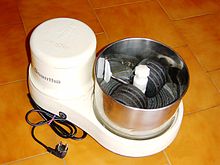కోయంబత్తూరు వెట్ గ్రైండర్

కోయంబత్తూరు వెట్ గ్రైండర్, భారత దేశము లోని తమిళనాడు రాష్ట్రము లోని తడి గ్రైండర్ల తయారును సూచిస్తుంది[1] ఇది 2005-06 సంవత్సరములో భారతదేశం యొక్క ప్రభుత్వం ఒక భౌగోళిక సూచన సంకేతంగా గుర్తించబడింది.[2] 2015 నాటికి, కోయంబత్తూరులో 700 కంటే ఎక్కువ వెట్ గ్రైండర్ తయారీదారులు ఉండి నెలవారీ అవుట్పుట్ 75,000 యూనిట్లుగా ఉంది.[3][4]
వెట్ గ్రైండర్[మార్చు]


ఒక వెట్ గ్రైండర్ ఆహార ధాన్యాల నుండి గ్రైడింగ్ తడి పిండి ఉత్పత్తి కోసం ఉపయోగించే ఒక ఆహార తయారీ పరికరం.[5] ఈ తడి పిండి (బ్యాటర్) దక్షిణ భారత ప్రముఖ వంటకాలు అయినటువంటి దోస, ఇడ్లీ, వడ, ఆప్పం, పణియారం వంటి వంటకాలలో విస్తృతంగా ఉపయోగిస్తారు.[6][7][8][9][10] ఇది గ్రానైట్ రాళ్ళు కలిగి ఒక మెటల్ డ్రమ్ లోపల తిరుగుతూ (రొటేట్) ఒక విద్యుత్ మోటార్ సహాయంతో పనిచేస్తుంది, ఆహార ధాన్యాలు రాతి, డ్రమ్ మధ్య నలిగిపోతూ పిండి తయారు అవుతుంది.[11]
చరిత్ర[మార్చు]
పి.సభాపతి ద్వారా 1955 సంవత్సరములో కోయంబత్తూరులో ఈ వెట్ గ్రైండర్ అభివృద్ధి చేయబడింది.[12][13][14] సభాపతిచెన్నై, మధురై వంటి ఇతర నగరాలకు కూడా ఈ గ్రైండర్లను ప్రవేశపెట్టడం జరిగింది.[14] 1963 సంవత్సరములో, పి.బి. కృష్ణమూర్తి ప్రవేశ పెట్టి, ప్రారంభించిన లక్ష్మి వెట్ (తడి) గ్రైండర్స్ విపరీత వాణిజ్య ప్రజాదరణకు దారితీసింది.[15] 1975 సంవత్సరములో, ఆర్.. దొరైస్వామి టిల్టింగ్ (ఒంపుకొనే తడి) వెట్ గ్రైండర్లను కనుగొన్నారు.[15][16] ఎల్.జి. వరదరాజ్, టేబుల్ టాప్ తడి గ్రైండర్లను పరిచయం చేశారు. ఇది నేలపై ఉంచే గ్రైండర్ల స్థానాన్ని దాదాపుగా ఆక్రమించింది.[15][17]
భౌగోళిక గుర్తింపు సంకేతం[మార్చు]
2005 సంవత్సరములో, భౌగోళిక గుర్తింపు సంకేతం గుర్తింపు కోసం తమిళనాడు ప్రభుత్వం కోయంబత్తూరు వెట్ గ్రైండర్ కోరకు దరఖాస్తు చేసుకుంది.[18] భారతదేశం ప్రభుత్వం 2005-06 సంవత్సరం నుంచి ఇది అధికారికంగా ఒక భౌగోళిక గుర్తింపు సంకేతం (జియోగ్రాఫికల్ ఇండికేషన్) వలె గుర్తించింది.[2]
మూలాలు[మార్చు]
- ↑ "Industry of Coimbatore". Coimbatore Corporation. Archived from the original on 30 జూలై 2015. Retrieved 28 June 2015.
- ↑ 2.0 2.1 "Geographical indication". Government of India. Archived from the original on 26 ఆగస్టు 2013. Retrieved 28 June 2015.
- ↑ "Wet grinder units form group to get SIDBI aid". Business Line. 24 March 2005. Retrieved 20 September 2009.
- ↑ "Poll code set to hit wet grinders business". Live Mint. 6 August 2015.
- ↑ Krishna Dubey (2010). The Indian Cuisine. PHI. p. 29. ISBN 9788120341708.
- ↑ Farnworth, Edward R. (2003). Handbook of Fermented Functional Foods. CRC Press. ISBN 978-0-8493-1372-1.
- ↑ Charmaine O' Brien (15 December 2013). The Penguin Food Guide to India. Penguin Books Limited. p. 378. ISBN 978-93-5118-575-8.
- ↑ K. T. Achaya. The Story of Our Food. Universities Press. pp. 80, 90. ISBN 81-7371-293-X.
- ↑ P. Thankappan Nair (2004). South Indians in Kolkata. Punthi Pustak. p. 320. ISBN 81-86791-50-7.
- ↑ Vir Sanghvi (1 January 2004). Rude Food: The Collected Food Writings of Vir Sanghvi. Penguin Books India. pp. 109–110. ISBN 978-0-14-303139-0.
- ↑ "How to choose a Wet grinder". indiacurry.com. Archived from the original on 19 డిసెంబరు 2014. Retrieved 24 January 2016.
- ↑ "How a wedding gift turned into a freebie". ’’Times of India’’. 31 March 2011.
- ↑ Diagnostic study of the "wet grinder cluster" at Coimbatore (PDF) (Report). Development Commissioner, Ministry of Micro, Small and Medium Enterprises. Archived from the original (PDF) on 3 మార్చి 2016. Retrieved 24 January 2016.
- ↑ 14.0 14.1 "Magic of the arc lights". The Hindu. 13 July 2011.
- ↑ 15.0 15.1 15.2 "Namma Coimbatore". The Hindu. 31 December 2013.
- ↑ "Santha Grinders". santhagrinders.com. Archived from the original on 9 జనవరి 2016. Retrieved 24 January 2016.
- ↑ "Coimbatore's engineering and textile industries are abuzz with activity, ending a period of slowdown". Frontline. Retrieved 24 January 2016.
- ↑ "GI tag: TN trails Karnataka with 18 products". Times of India. 29 August 2013.